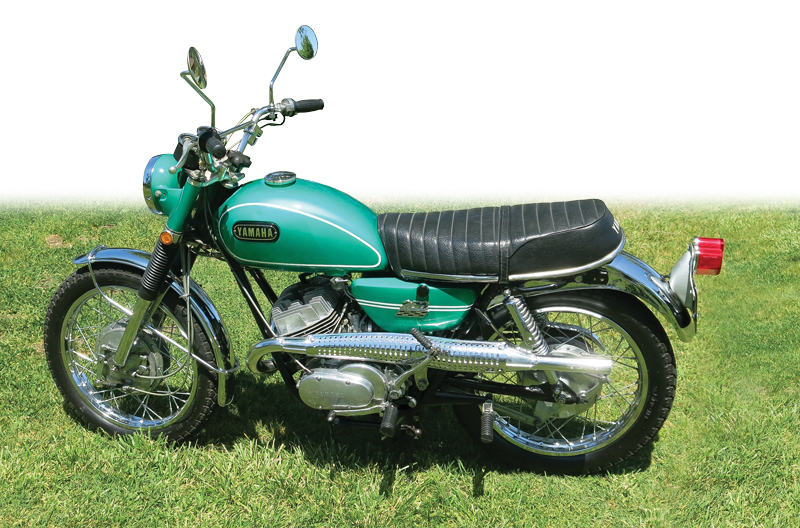
For more than 10 years 250 two-stroke twins were the mainstay of the Yamaha range here in the United States, from the DS1 of 1959 (though not sold in the U.S. until 1961) to the DS7 of 1972. We have no idea what the DS stands for, but doubt that it has anything to do with the DS prefix used in Yamaha’s music department. Two-strokes were the popular engines for sporty bikes in the 1960s, being reasonably powerful and inexpensive to make. Running against this 250 DS6 were Suzuki’s Hustler and Kawasaki’s Samurai, all in the $600 range. Any college student having a few bucks in his pocket could probably arrange time payments with the local dealer…backed by Dad’s signature.
When Yamaha advertised this quarter-liter as having 30 horsepower, interest was great. And it passed the eye test as well, with high pipes, one on each side. This was styled as a dual-purpose machine–hence the C in the alpha numerology. The chassis design was much more favorable to the street rather than the trail, so the high pipes were more a styling point rather than functional.
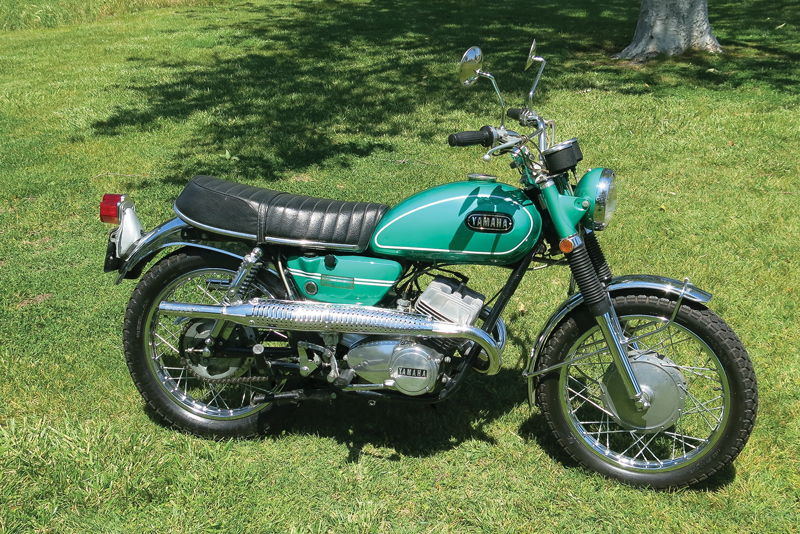 The history of the DS6 engine was long and had the distinct advantage of being associated with Yamaha’s racing 250, the TD1, which had great success over the previous decade. Riders could thank Yamaha’s racing shop for improvements, as the company was intent on keeping its 250 riders on the podium. And what is good on the track can be tuned down to find its place on the street. Any time the engineers improved the racer, they would try to figure out a way to adapt whatever it was to the street bike. Ads for the DS6 promoted the TD’s Daytona wins in 1967 and 1968.
The history of the DS6 engine was long and had the distinct advantage of being associated with Yamaha’s racing 250, the TD1, which had great success over the previous decade. Riders could thank Yamaha’s racing shop for improvements, as the company was intent on keeping its 250 riders on the podium. And what is good on the track can be tuned down to find its place on the street. Any time the engineers improved the racer, they would try to figure out a way to adapt whatever it was to the street bike. Ads for the DS6 promoted the TD’s Daytona wins in 1967 and 1968.
The DS6 246cc engine was of piston-port design, with the 56mm bore and 50mm stroke that had been around for 10 years. This was a genuine five-porter, the ports being cast into the aluminum cylinders with cast iron liners. The new for ’69 cylinders had three transfer ports, along with intake and exhaust, allowing for a larger fuel charge to find its way into the combustion chambers faster. Compression ratio was a reliable 7.3:1, and the cylinders now had copper head gaskets to replace the earlier aluminum ones–which had a tendency to fail when pushed very hard. Naturally these new gaskets came from the racing TDs. Inside the engine were race-worthy bearings, though they would never be subjected to the 10,000-plus rpm attained by TDs. Those 30 advertised horses were said to be generated at 7,500 rpm, and were certainly taken off the crankshaft rather than the rear wheel. Road tests merely quoted the “claimed bhp.”
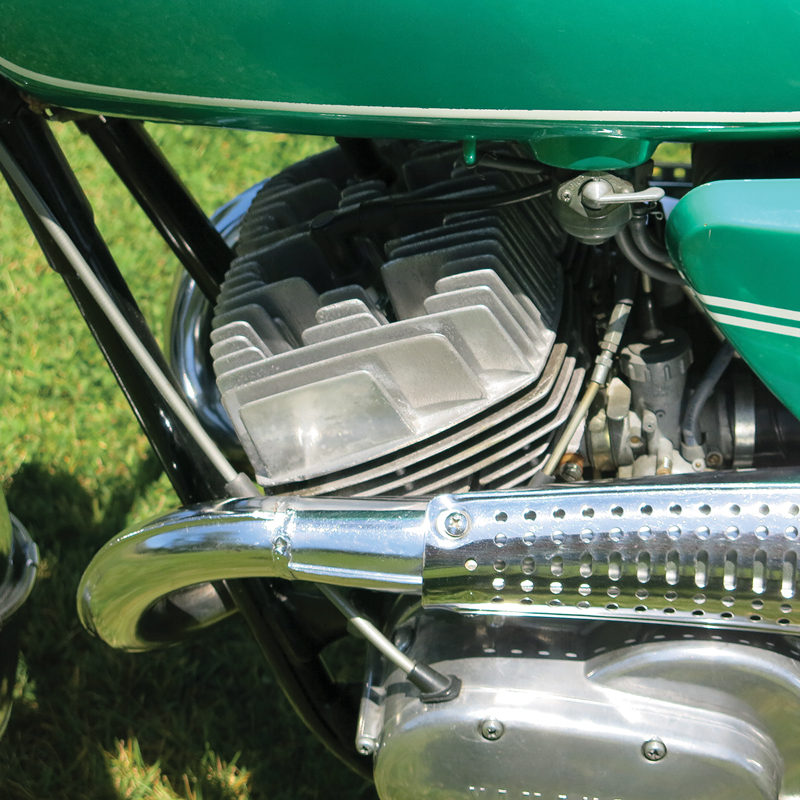 Two 26mm Mikuni VMC two-stroke carbs combined with Yamaha’s Autolube system fed the fuel/oil mixture into the crankcase. Yamaha was noted for having developed the Autolube system, using a separate container for oil rather than messily mixing it with gas in the tank. It was being used on Yamaha’s race bikes in the late ’50s, and then adapted to street machines in the early ’60s. The greatest advantage to Autolube was that it could closely regulate the amount of oil to be mixed with the gas, so instead of having a steady 20:l mixture, which could get quite smoky at times, the oil was metered by both engine speed and the opening of the throttle valves. This could diminish oil input when idling through town, and give it an almighty whack when the rider decided that a full-on accelerator rush down a country road was in order. The oil capacity was three pints, which was good for half a dozen fill-ups of the 3-gallon gas tank.
Two 26mm Mikuni VMC two-stroke carbs combined with Yamaha’s Autolube system fed the fuel/oil mixture into the crankcase. Yamaha was noted for having developed the Autolube system, using a separate container for oil rather than messily mixing it with gas in the tank. It was being used on Yamaha’s race bikes in the late ’50s, and then adapted to street machines in the early ’60s. The greatest advantage to Autolube was that it could closely regulate the amount of oil to be mixed with the gas, so instead of having a steady 20:l mixture, which could get quite smoky at times, the oil was metered by both engine speed and the opening of the throttle valves. This could diminish oil input when idling through town, and give it an almighty whack when the rider decided that a full-on accelerator rush down a country road was in order. The oil capacity was three pints, which was good for half a dozen fill-ups of the 3-gallon gas tank.
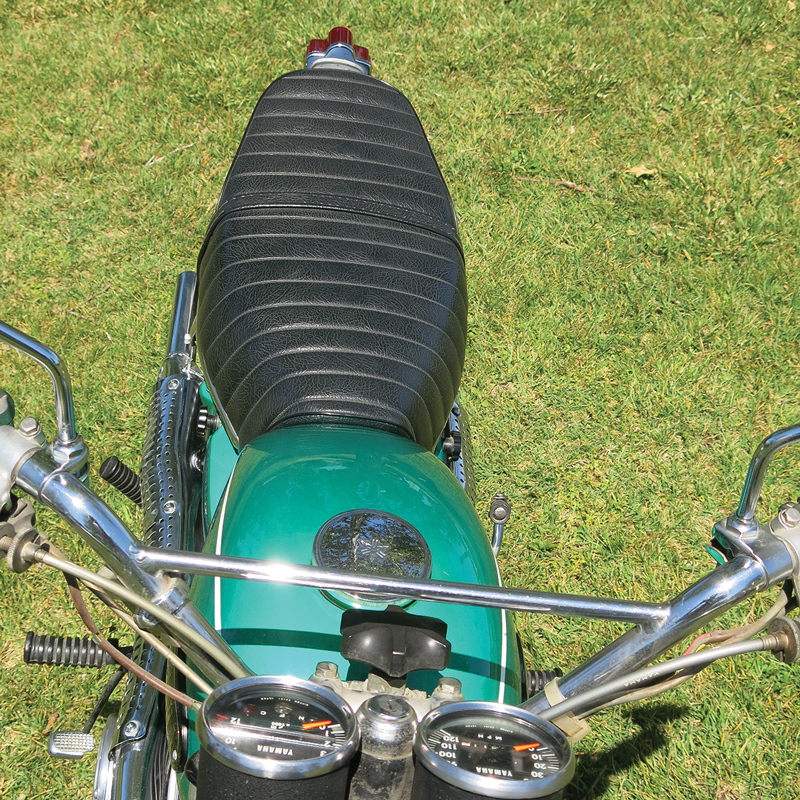 Crankshaft power ran back the left side via helical gears to a seven plate clutch, blessed with six torsion springs that helped to absorb even the most abrupt of gear changes. And rubber cushions in the hub helped reduce vibration. Smoothness was what the rider felt when going through the five gears. All this sat securely in a tubular steel double-cradle frame, which looked remarkably like that on a race bike.
Crankshaft power ran back the left side via helical gears to a seven plate clutch, blessed with six torsion springs that helped to absorb even the most abrupt of gear changes. And rubber cushions in the hub helped reduce vibration. Smoothness was what the rider felt when going through the five gears. All this sat securely in a tubular steel double-cradle frame, which looked remarkably like that on a race bike.
A rather steep 34mm telescopic fork ran down to the 18-inch front wheel, where a 7-inch double-leading-shoe front brake did an excellent job of slowing things down. The rear swingarm had a pair of shocks with adjustments available for spring preload. And the wheel, another 18-incher, also had a 7-inch brake, but with a single leading shoe. The 50.8-inch wheelbase was a quick handler on the street, but would keep the sensible trail rider at a more modest pace.
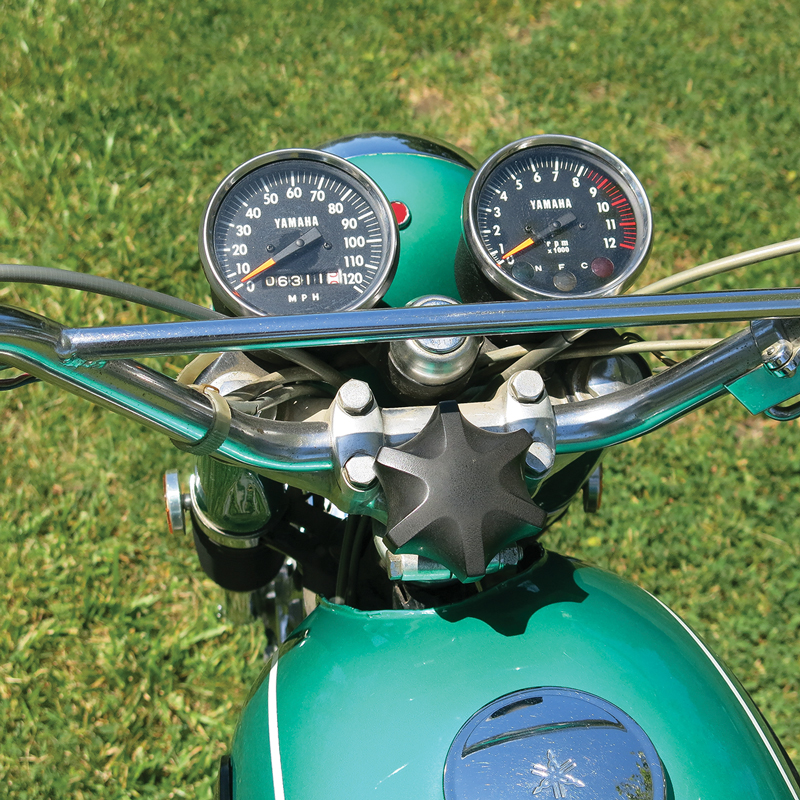 The look was quite different from the preceding low-pipe DS5, which had a rather bulbous 4-gallon tank, and speedometer and tach built into one unit. The smaller 3-gallon teardrop tank was much more attractive in appearance, and the speedo and tach were now separate…very English. Long, flat saddle and chromed metal fenders added to the good looks, going along with the upswept pipes–which did have protective heat-shielding, but long pants were advisable. Yamaha had dropped a tooth from the DS5 countershaft sprocket, which reduced the top speed a small amount, down to 90 or so mph–depending on the weight sitting on the saddle. And a skid plate was bolted on, more for looks than the thought that this shiny fellow would ever scrape its underbelly.
The look was quite different from the preceding low-pipe DS5, which had a rather bulbous 4-gallon tank, and speedometer and tach built into one unit. The smaller 3-gallon teardrop tank was much more attractive in appearance, and the speedo and tach were now separate…very English. Long, flat saddle and chromed metal fenders added to the good looks, going along with the upswept pipes–which did have protective heat-shielding, but long pants were advisable. Yamaha had dropped a tooth from the DS5 countershaft sprocket, which reduced the top speed a small amount, down to 90 or so mph–depending on the weight sitting on the saddle. And a skid plate was bolted on, more for looks than the thought that this shiny fellow would ever scrape its underbelly.
The DS6-C weight was down 20 pounds on DS5, weighing 304 pounds dry. Much of that had to do with the absence of an electric starter. Firing up this baby was done the old-fashioned way…admittedly a very simple task.
The DS series was a great sales success, lasting until the RD250s took over in 1973.

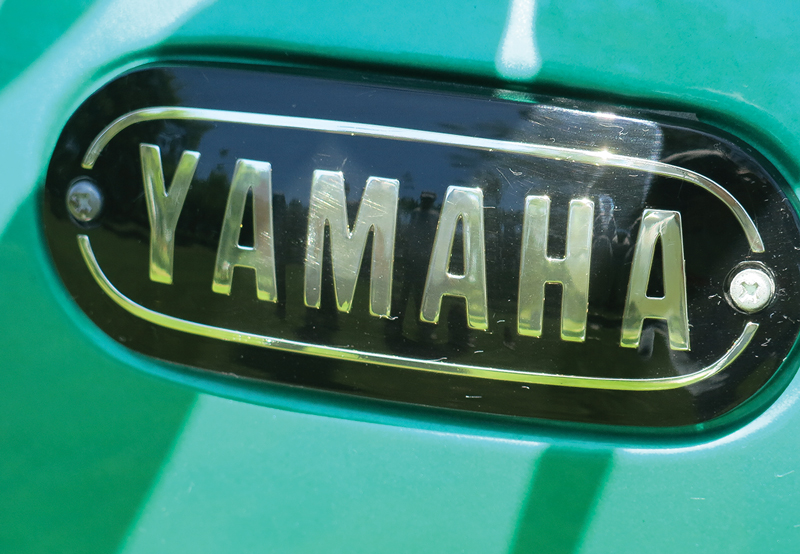
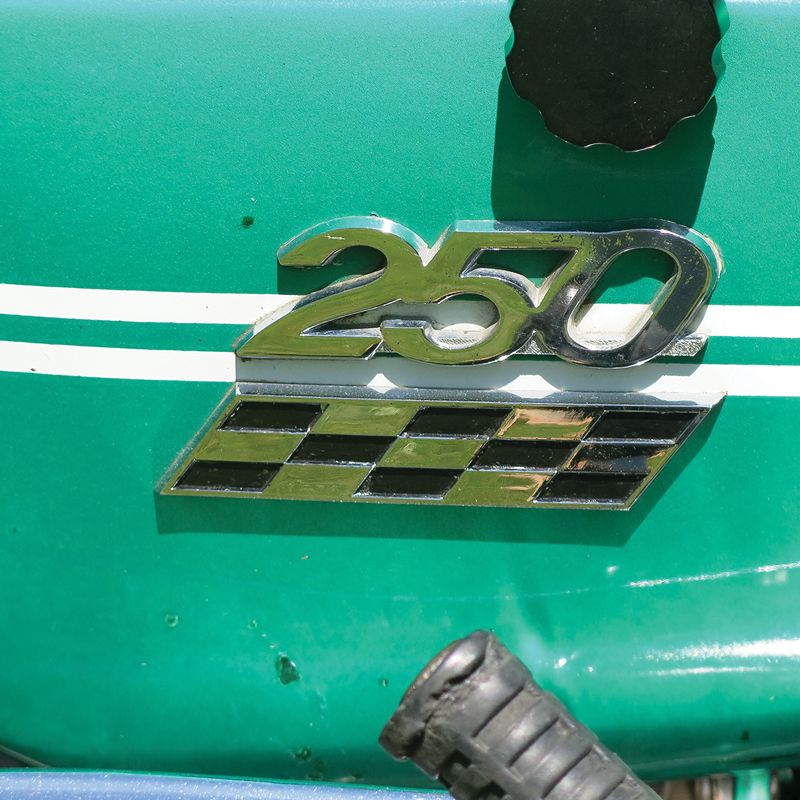







had one brand new way back in 69. thought it would be a bit sluggish after my 650 ss norton, but it was so much quicker in the acceleration dept it was bloody scary you could not hold the front wheel on the ground in first or second gear but the sad bit of it was it had an air leak in one cylinder and it kept melting the spark plug electrode dropping it onto the piston. no more to be said. bloody shame loved that bike but they could not find the leak.
Interesting story, air leak. Mine had an oil leak, leaky main bering that ended up sucking up all the oil in the Autolub tank, resulting in a seizure on a long 75MPH road trip.
I too had a 1969. Rode it across country from New Hampshire to Arizona.
I was young and skinny… Could keep front end off ground through third gear! Wish I still had it.
I owned one of these machines from 1975 until 2005 ! I rode it everywhere in New Zealand and raced it at club meetings in the 250cc class. I re-bored the cylinders once and replaced pistons, rings and wrist bearings several times, as I road it for many thousands of miles, with very few problems.
It was quicker than the YDS7, the RD250A and B models and it took Yamaha until the RD250C model to build a faster 250 !
I too, wish I had never sold it!
I’ve got a 1969 DS six 250 CC complete no parts missing runs great looks great. Original paint job is yellow. Itwas only one I’ve seen wIth this color the kick start on the left the only other one I seen with this color is England as 9800 miles on it excellent shape and I still have it sitting in my garage and it runs great. For sale
Your post is 6 months ago, any chance it’s still available?